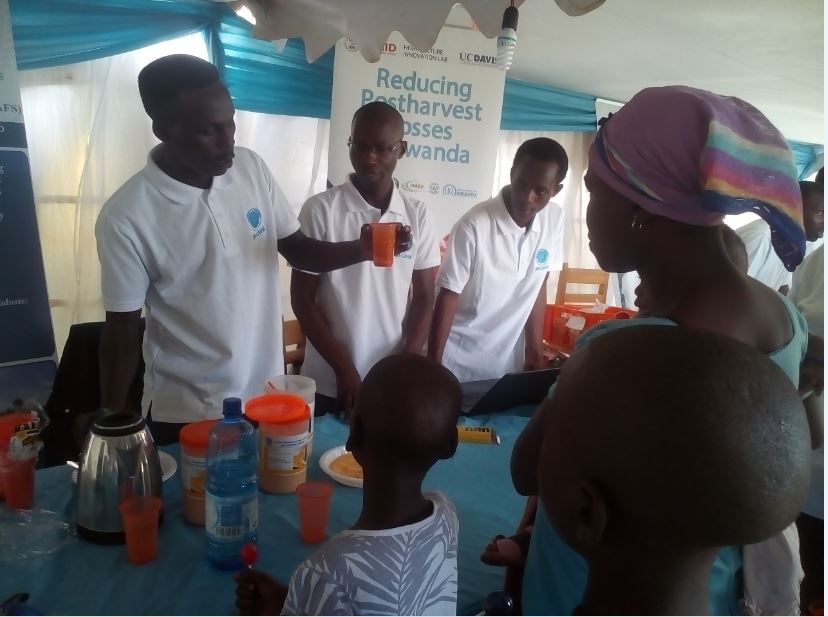
CAVM studenrts at agri show
Two months ago, Jean Damascene Rubayiza went in holiday in Bugesera district, Eastern province and witnessed a scenario that he still doesn’t understand.
He watched his mother harvest one tone of sweet potatoes, take them to the market only to sell a half of them.
He could not stand seeing this.
As a 4th year student of science and technology at the University of Rwanda College of Agriculture, Animal Science and Veterinary Medicine (CAVM), this bothered but inspired him to think of using his education to do something.
With the help of his school, he collected potatoes, pounded them and took powder to the university laboratory to start sampling the nutritional ingredients.
In the tests, he found out that potato flour was rich in proteins and vitamin A- which are essential for skin health, brain function, heart, kidneys, lungs, vision, and the immune system. He thus found that he could propose potato porridge, which also would solve the problem of loss of sweet potatoes.
From potatoes, Rubayiza continued his research to add in more ingredients.
“After succeeding in the potato research, we added another nutritional quality of soya, to make a porridge floor which is perfect for the human growth, especially for children and prevention of disease like malnutrition,” Rubayiza said.
Soya is a saturated fat and high in protein, vitamin C, and folate, a good source of fiber, calcium, iron, magnesium, phosphorus, potassium, and thiamin- which enables the body to use carbohydrates as energy.
Once this is sorted out, the full mixture of both powder is ready for consumption and no need of adding sugar- which is already covered in the sweetness of the potatoes.
At this stage, the mixed powders, yellowish in color, are ready for drinking as an instant porridge but with a mix of very .hot water and stirring with a table spoon.
“This saves time for anyone who is in hurry, it can be consumed at the office or at home, along a family trip, especially for keeping children healthy,” said Rubayiza.
This innovation, currently being exposed at the 14th agriculture expo in Mulindi grounds in Kigali, could change the approach of fight malnutrition in rural communities. Malnutrition numbers stood at 38.2% at the start of 2019.
Hundreds of Rwandan women and children got a chance to taste free of charge, the yellow porridge drink at the CAVM expo stand and but many showed interest of learning how to make the porridge at home and asked for the commercialization of the product.
“I am surprised that porridge can be made out of sweet potatoes. The porridge is sweet and the process of making it is very simple, which I think I can try out at home,” Jeanine Muhawenimana, a mother of four children said.
CAVM officials said that the porridge is still at trial stage but there are plans to try out the product in the Musanze community- where the university operates, in order to access its impact in addressing malnutrition cases.
Dr. Guillaume Nyagatare CAVM Director of research and innovation said that the student’s exposure at the agriculture expo was aimed at opening doors for partnerships with private investors with plans to work with the communities.
“We are now working to attract funds, for others to work with our students,” Nyagaatre said.
He added that the bigger plan is to work with farmer’s communities especially in building trust to work with students to innovate together in areas of adding value to post harvest agricultural products, fabricating agro equipment which are already under test-research at CAVM.
Some of the other student innovations in adding value to crop harvests include, producing jam out tomatoes, bread out of soya.

